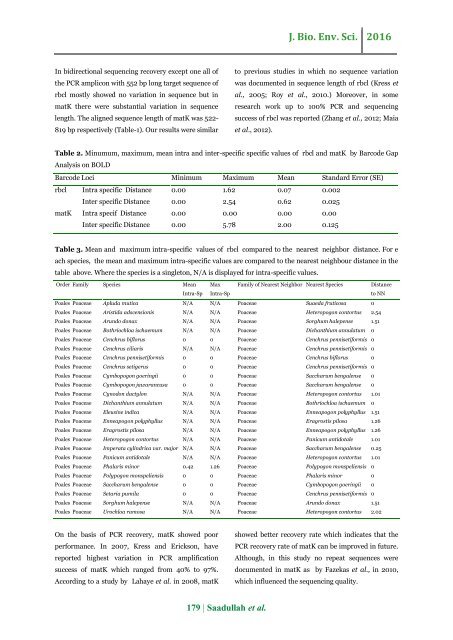Identification of the grass family (Poaceae) by using the plant dna barcodes rbcl and matK
Abstract Due to phenotypic plasticity, with few distinguishable and many overlapping characters, grasses are very difficult to identify by morphological characters, The current research evaluated how standard plant barcode rbcl and matK can help in floristic evaluation of. grasses belonging to a not well studied flora in district Dera Ghazi Khan, Punjab, Pakistan. In this study, 54 specimen belonging to 24 species of Poaceae were examined. Species wise sequencing success for rbcl and matK was 100% and 66.67% respectively. The determination of intra and inter-specific divergence and phylogentic analysis by reconstruction of neighbor joining trees were carried out. The results demonstrated that individually both rbcl and matK totally failed in discrimination of congeneric species. In neighbor joining phylogenetic analysis both rbcl and matK provided well resolved monophyletic tree with weak bootstrap threshold value. While in combination (rbcl+matK) both marker provided well resolved monophyletic tree with strong bootstrap threshold value.
Abstract
Due to phenotypic plasticity, with few distinguishable and many overlapping characters, grasses are very difficult to identify by morphological characters, The current research evaluated how standard plant barcode rbcl and matK can help in floristic evaluation of. grasses belonging to a not well studied flora in district Dera Ghazi Khan, Punjab, Pakistan. In this study, 54 specimen belonging to 24 species of Poaceae were examined. Species wise sequencing success for rbcl and matK was 100% and 66.67% respectively. The determination of intra and inter-specific divergence and phylogentic analysis by reconstruction of neighbor joining trees were carried out. The results demonstrated that individually both rbcl and matK totally failed in discrimination of congeneric species. In neighbor joining phylogenetic analysis both rbcl and matK provided well resolved monophyletic tree with weak bootstrap threshold value. While in combination (rbcl+matK) both marker provided well resolved monophyletic tree with strong bootstrap threshold value.
You also want an ePaper? Increase the reach of your titles
YUMPU automatically turns print PDFs into web optimized ePapers that Google loves.
J. Bio. Env. Sci. 2016<br />
In bidirectional sequencing recovery except one all <strong>of</strong><br />
<strong>the</strong> PCR amplicon with 552 bp long target sequence <strong>of</strong><br />
<strong>rbcl</strong> mostly showed no variation in sequence but in<br />
<strong>matK</strong> <strong>the</strong>re were substantial variation in sequence<br />
length. The aligned sequence length <strong>of</strong> <strong>matK</strong> was 522-<br />
819 bp respectively (Table-1). Our results were similar<br />
to previous studies in which no sequence variation<br />
was documented in sequence length <strong>of</strong> <strong>rbcl</strong> (Kress et<br />
al., 2005; Roy et al., 2010.) Moreover, in some<br />
research work up to 100% PCR <strong>and</strong> sequencing<br />
success <strong>of</strong> <strong>rbcl</strong> was reported (Zhang et al., 2012; Maia<br />
et al., 2012).<br />
Table 2. Minumum, maximum, mean intra <strong>and</strong> inter-specific specific values <strong>of</strong> <strong>rbcl</strong> <strong>and</strong> <strong>matK</strong> <strong>by</strong> Barcode Gap<br />
Analysis on BOLD<br />
Barcode Loci Minimum Maximum Mean St<strong>and</strong>ard Error (SE)<br />
<strong>rbcl</strong> Intra specific Distance 0.00 1.62 0.07 0.002<br />
Inter specific Distance 0.00 2.54 0.62 0.025<br />
<strong>matK</strong> Intra specif Distance 0.00 0.00 0.00 0.00<br />
Inter specific Distance 0.00 5.78 2.00 0.125<br />
Table 3. Mean <strong>and</strong> maximum intra-specific values <strong>of</strong> <strong>rbcl</strong> compared to <strong>the</strong> nearest neighbor distance. For e<br />
ach species, <strong>the</strong> mean <strong>and</strong> maximum intra-specific values are compared to <strong>the</strong> nearest neighbour distance in <strong>the</strong><br />
table above. Where <strong>the</strong> species is a singleton, N/A is displayed for intra-specific values.<br />
Order Family Species Mean<br />
Intra-Sp<br />
Max<br />
Intra-Sp<br />
Family <strong>of</strong> Nearest Neighbor Nearest Species<br />
Distance<br />
to NN<br />
Poales <strong>Poaceae</strong> Apluda mutica N/A N/A <strong>Poaceae</strong> Suaeda fruticosa 0<br />
Poales <strong>Poaceae</strong> Aristida adscensionis N/A N/A <strong>Poaceae</strong> Heteropogon contortus 2.54<br />
Poales <strong>Poaceae</strong> Arundo donax N/A N/A <strong>Poaceae</strong> Sorghum halepense 1.51<br />
Poales <strong>Poaceae</strong> Bothriochloa ischaemum N/A N/A <strong>Poaceae</strong> Dichanthium annulatum 0<br />
Poales <strong>Poaceae</strong> Cenchrus biflorus 0 0 <strong>Poaceae</strong> Cenchrus pennisetiformis 0<br />
Poales <strong>Poaceae</strong> Cenchrus ciliaris N/A N/A <strong>Poaceae</strong> Cenchrus pennisetiformis 0<br />
Poales <strong>Poaceae</strong> Cenchrus pennisetiformis 0 0 <strong>Poaceae</strong> Cenchrus biflorus 0<br />
Poales <strong>Poaceae</strong> Cenchrus setigerus 0 0 <strong>Poaceae</strong> Cenchrus pennisetiformis 0<br />
Poales <strong>Poaceae</strong> Cymbopogon goeringii 0 0 <strong>Poaceae</strong> Saccharum bengalense 0<br />
Poales <strong>Poaceae</strong> Cymbopogon jawarancusa 0 0 <strong>Poaceae</strong> Saccharum bengalense 0<br />
Poales <strong>Poaceae</strong> Cynodon dactylon N/A N/A <strong>Poaceae</strong> Heteropogon contortus 1.01<br />
Poales <strong>Poaceae</strong> Dichanthium annulatum N/A N/A <strong>Poaceae</strong> Bothriochloa ischaemum 0<br />
Poales <strong>Poaceae</strong> Eleusine indica N/A N/A <strong>Poaceae</strong> Enneapogon polyphyllus 1.51<br />
Poales <strong>Poaceae</strong> Enneapogon polyphyllus N/A N/A <strong>Poaceae</strong> Eragrostis pilosa 1.26<br />
Poales <strong>Poaceae</strong> Eragrostis pilosa N/A N/A <strong>Poaceae</strong> Enneapogon polyphyllus 1.26<br />
Poales <strong>Poaceae</strong> Heteropogon contortus N/A N/A <strong>Poaceae</strong> Panicum antidotale 1.01<br />
Poales <strong>Poaceae</strong> Imperata cylindrica var. major N/A N/A <strong>Poaceae</strong> Saccharum bengalense 0.25<br />
Poales <strong>Poaceae</strong> Panicum antidotale N/A N/A <strong>Poaceae</strong> Heteropogon contortus 1.01<br />
Poales <strong>Poaceae</strong> Phalaris minor 0.42 1.26 <strong>Poaceae</strong> Polypogon monspeliensis 0<br />
Poales <strong>Poaceae</strong> Polypogon monspeliensis 0 0 <strong>Poaceae</strong> Phalaris minor 0<br />
Poales <strong>Poaceae</strong> Saccharum bengalense 0 0 <strong>Poaceae</strong> Cymbopogon goeringii 0<br />
Poales <strong>Poaceae</strong> Setaria pumila 0 0 <strong>Poaceae</strong> Cenchrus pennisetiformis 0<br />
Poales <strong>Poaceae</strong> Sorghum halepense N/A N/A <strong>Poaceae</strong> Arundo donax 1.51<br />
Poales <strong>Poaceae</strong> Urochloa ramosa N/A N/A <strong>Poaceae</strong> Heteropogon contortus 2.02<br />
On <strong>the</strong> basis <strong>of</strong> PCR recovery, <strong>matK</strong> showed poor<br />
performance. In 2007, Kress <strong>and</strong> Erickson, have<br />
reported highest variation in PCR amplification<br />
success <strong>of</strong> <strong>matK</strong> which ranged from 40% to 97%.<br />
According to a study <strong>by</strong> Lahaye et al. in 2008, <strong>matK</strong><br />
showed better recovery rate which indicates that <strong>the</strong><br />
PCR recovery rate <strong>of</strong> <strong>matK</strong> can be improved in future.<br />
Although, in this study no repeat sequences were<br />
documented in <strong>matK</strong> as <strong>by</strong> Fazekas et al., in 2010,<br />
which influenced <strong>the</strong> sequencing quality.<br />
179 | Saadullah et al.





![Review on: impact of seed rates and method of sowing on yield and yield related traits of Teff [Eragrostis teff (Zucc.) Trotter] | IJAAR @yumpu](https://documents.yumpu.com/000/066/025/853/c0a2f1eefa2ed71422e741fbc2b37a5fd6200cb1/6b7767675149533469736965546e4c6a4e57325054773d3d/4f6e6531383245617a537a49397878747846574858513d3d.jpg?AWSAccessKeyId=AKIAICNEWSPSEKTJ5M3Q&Expires=1715029200&Signature=4CyO8Zq9RSk2mJqpCHIc9uaLXXI%3D)












